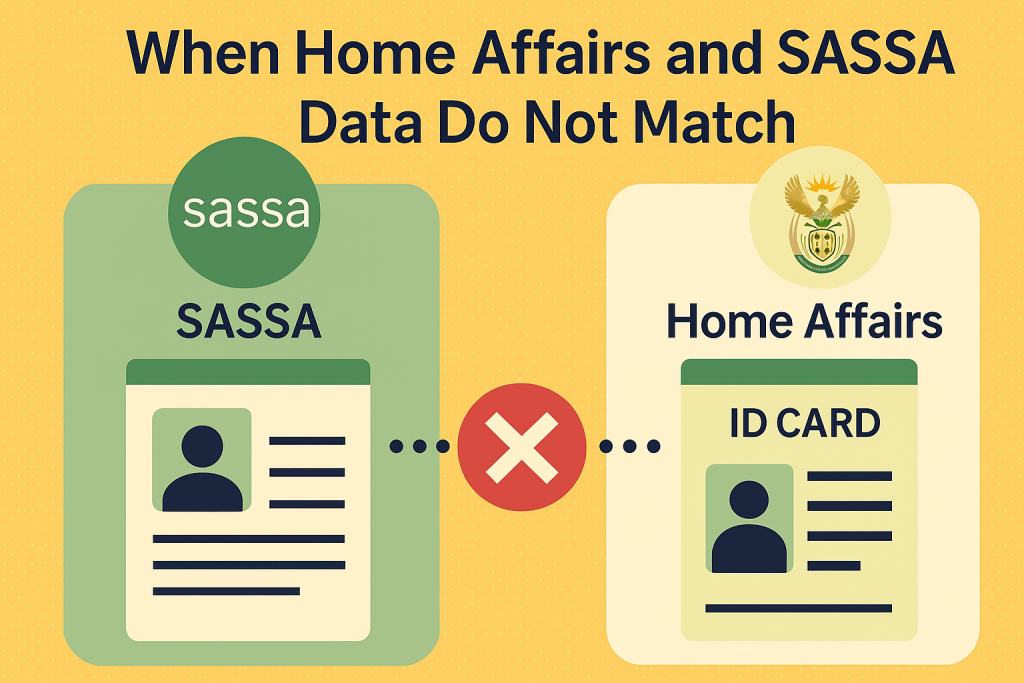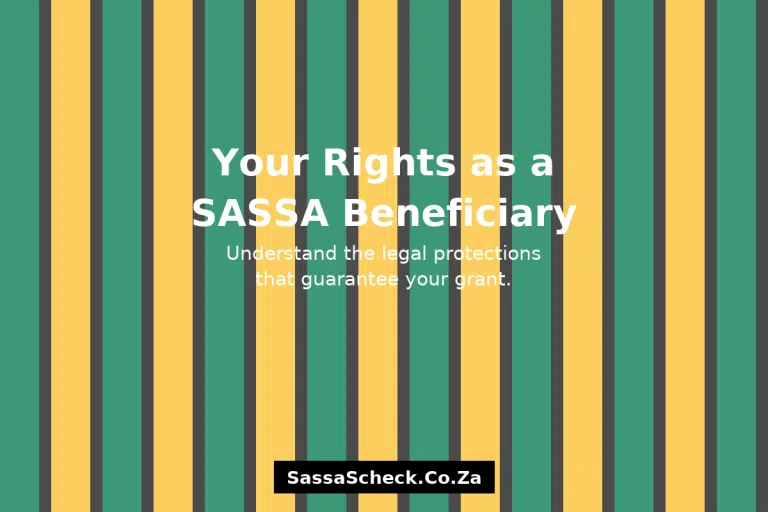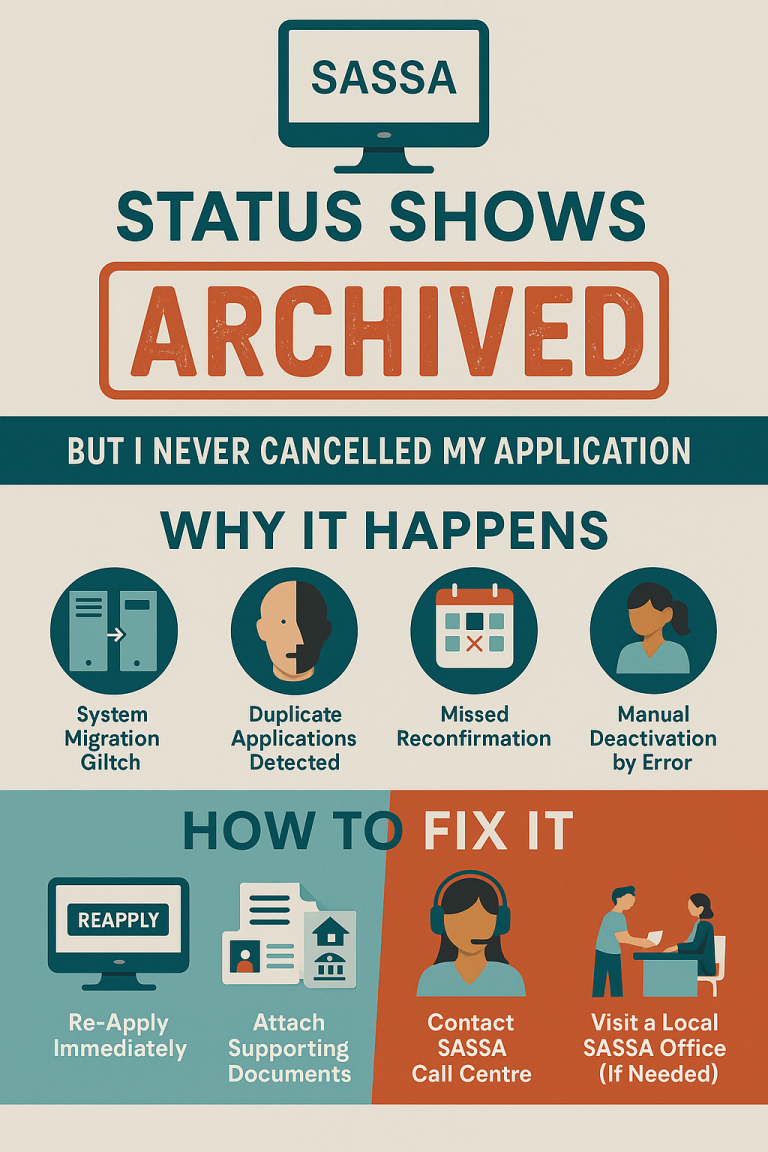When Home Affairs and SASSA Data Do Not Match
Every SASSA beneficiary’s identity starts with one thing their Home Affairs record. Every application, whether online or in person, depends on data shared between SASSA and the Department of Home Affairs (DHA). Yet, many people discover that even a tiny difference in this data can block their grants for months.

This mismatch between two government systems has quietly become one of the most common reasons for failed applications, suspended grants, or endless “Pending” statuses. It’s a silent problem, hidden behind official systems that rarely communicate properly.
The Two Systems That Don’t Speak Clearly
SASSA and Home Affairs are meant to share real-time information through a national verification network. When you apply for a grant, your ID number, name, and date of birth are checked against DHA’s database to confirm that you exist, are alive, and are a South African citizen or permanent resident.
However, this connection is not seamless. It runs on an intermittent data link that often goes offline or uses cached (old) information from previous synchronisations. This means the SASSA system might be looking at data from a week or even a month ago.
If your Home Affairs details were recently updated for example, after a name change, marriage, or death certificate update — the SASSA system may not yet reflect that.
Common Causes of Data Mismatch
Spelling Differences
A small change in your name or surname even one missing letter or hyphen can cause an error. The system does not automatically assume it’s the same person.
Date of Birth Conflicts
If Home Affairs updated your date of birth (common in older ID corrections), the new date might not pull through to SASSA.
Identity Reconstruction
Some citizens undergo an ID reissue after losing documents or correcting past records. This process can create a “new” ID profile that doesn’t link back to the old grant record.
Dual Records
There are rare cases where Home Affairs accidentally creates two active profiles for one person. SASSA’s algorithm gets confused about which one to trust and flags both as inconsistent.
Why the Error Isn’t Easy to Fix
The most frustrating part of this issue is that SASSA staff at local offices cannot fix it immediately. The data verification happens on a national server shared by both departments. Local staff can only submit a “Form A” (data correction request) which is then forwarded to a verification officer who has limited access to the central identity system.
That process can take weeks because SASSA and DHA must both confirm which record is “official.” Until that happens, your file remains stuck even if you bring all your documents physically.
The Human Side of the Problem
Imagine a grandmother in rural Eastern Cape who applied for an Old Age Grant. She has an ID that shows her birth date as 1953, but Home Affairs still lists 1955. When SASSA verifies her ID, the mismatch returns an “invalid date range” error.
No one tells her this. The online tracker just says “Application Pending.” She visits the office again and again, waiting for a system that’s trying to compare two different truths.
What Really Happens in the Backend
Inside the SASSA verification system, there’s a hidden code called “ID_VER_FAIL.” This code appears whenever the identity number sent to Home Affairs doesn’t match the full name or date of birth returned.
When this happens, the application doesn’t go to “Declined” status immediately. It goes into a loop — a background retry process that checks again every few days. However, the retry process can only work if the network link between SASSA and Home Affairs is active. If the link is down, the file stays in the loop indefinitely.
That’s why some applications stay “Pending” for months without any visible change.
Why Many Mismatches Happen After Marriage
One of the biggest unseen causes of mismatch is the change in surnames after marriage. When women update their surnames at Home Affairs, SASSA doesn’t always receive the update automatically. The system keeps searching for the old surname, assuming the new one is a different person.
Unless the applicant physically brings the marriage certificate and requests a manual link, the mismatch will never correct itself. This happens to thousands of female grant applicants every year, but few realise it’s the reason for their failed status.
The Role of Death Records
Home Affairs also maintains a database of deceased persons. If your ID accidentally appears on that list which can happen due to clerical errors or duplicate numbers your SASSA account will be marked as “Deceased.”
Once that happens, the grant is immediately stopped. Reversing it requires both Home Affairs and SASSA to confirm your living status through a live verification form, which can take months. Several people have had to travel long distances just to “prove” they’re alive.
A Quiet Effort to Fix It
In 2024, SASSA began testing a new digital bridge called the Identity Sync Gateway (ISG) a system designed to reduce mismatches by checking both databases simultaneously instead of sequentially.
The ISG allows real-time comparison of ID numbers and names across both systems. Early results from pilot regions in KwaZulu-Natal show a reduction in verification errors, but the rollout is still slow.
Once fully implemented, the gateway could help applicants get instant confirmation that their details match avoiding months of confusion.
What Beneficiaries Can Do Now
Until the new system is active nationwide, beneficiaries should always confirm their Home Affairs details before applying.
If there’s even a small change in your name, surname, or ID details, fix it first at the DHA office. Then wait at least seven days before reapplying to SASSA, giving the databases time to sync.
It’s also wise to keep proof of any updates or corrections, as these can help SASSA trace the cause if your grant gets stuck.
Conclusion
When Home Affairs and SASSA data do not match, the system sees you as two different people even if you’ve lived your whole life under one name. This disconnect is not about fraud or error on your part; it’s about outdated communication between two government systems that still rely on manual syncing.
For the millions depending on social grants, this invisible technical gap is more than a data problem it’s a human one. Every mismatch means a mother, a pensioner, or a child support recipient waiting longer for help they rightfully deserve.
Until these systems finally talk to each other in real time, South Africans will continue to live between two identities: one on paper, and one in the database.






